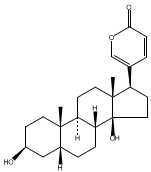Home
Products
Bufalin



| Product Name | Bufalin |
| Price: | $131 / 20mg |
| Catalog No.: | CN02567 |
| CAS No.: | 465-21-4 |
| Molecular Formula: | C24H34O4 |
| Molecular Weight: | 386.52 g/mol |
| Purity: | >=98% |
| Type of Compound: | Steroids |
| Physical Desc.: | White powder |
| Source: | The glandular body of Bufo bufo gargarizans Cantor. |
| Solvent: | Chloroform, Dichloromethane, Ethyl Acetate, DMSO, Acetone, etc. |
| SMILES: | O[C@H]1CC[C@H]2[C@@H](C1)CC[C@H]1[C@@H]2CC[C@]2([C@@]1(O)CC[C@H]2c1ccc(=O)oc1)C |
| Contact us | |
|---|---|
| First Name: | |
| Last Name: | |
| E-mail: | |
| Question: | |
| Description | Bufalin a major digoxin-like immunoreactive component of the Chinese medicine Chan Su; has been shown to exert a potential for anticancer activity against various human cancer cell lines in vitro.IC50 value:Target: Anticaner natural compoundin vitro: bufalin remarkably inhibited growth in human gallbladder cancer cells by decreasing cell proliferation, inducing cell cycle arrest and apoptosis in a dose-dependent manner. Bufalin also disrupted the mitochondrial membrane potential (ΔΨm) and regulated the expression of cell cycle and apoptosis regulatory molecules. Activation of caspase-9 and the subsequent activation of caspase-3 indicated that bufalin may be inducing mitochondria apoptosis pathways [1]. bufalin suppressed the protein levels associated with DNA damage and repair, such as a DNA dependent serine/threonine protein kinase (DNA-PK), DNA repair proteins breast cancer 1, early onset (BRCA1), 14-3-3 σ (an important checkpoint keeper of DDR), mediator of DNA damage checkpoint 1 (MDC1), O6-ethylguanine-DNA methyltransferase (MGMT) and p53 (tumor suppressor protein) [2]. TNF-α significantly increased p65 translocation into nucleus (P < 0.01) and enhanced NF-κB DNA-binding activity, which were dose-dependently inhibited by bufalin. Furthermore, bufalin attenuated the TNF-α-induced interleukin-1beta (IL-1β), IL-6, and IL-8 production in RAFLSs in a concentration-dependent manner [3]. bufalin enhanced TRAIL-induced apoptosis in MCF-7 and MDA-MB-231 breast cancer cells by activating the extrinsic apoptotic pathway. Bufalin also promoted the clustering of death receptor 4 (DR4) and DR5 in aggregated lipid rafts [4].in vivo: bufalin (0.3 and 0.6 mg/kg, i.p.) potently decreased carrageenan-induced paw edema. Bufalin down regulated the expression levels of nitric oxide synthase (iNOS), cyclooxygenase-2 (COX-2), interleukin-1β (IL-1β), interleukin-6 (IL-6), and tumor necrosis factor-α (TNF-α) during these treatments [5]. |
| Density | 1.2±0.1 g/cm3 |
| Boiling Point | 556.6±50.0 °C at 760 mmHg |
| Flash Point | 189.0±23.6 °C |
| Exact Mass | 386.245697 |
| PSA | 70.67000 |
| LogP | 3.42 |
| Vapour Pressure | 0.0±3.4 mmHg at 25°C |